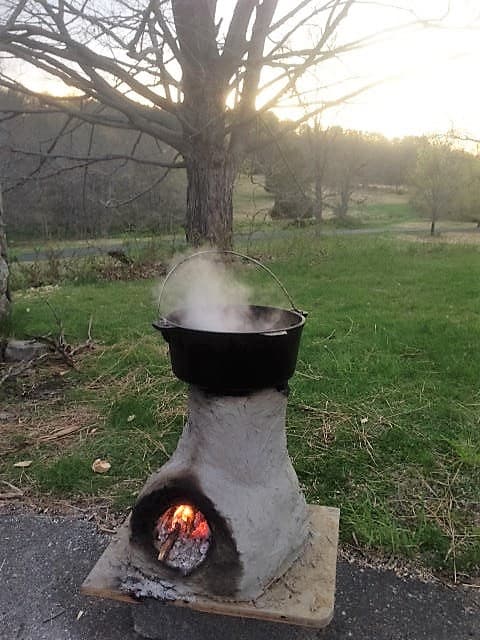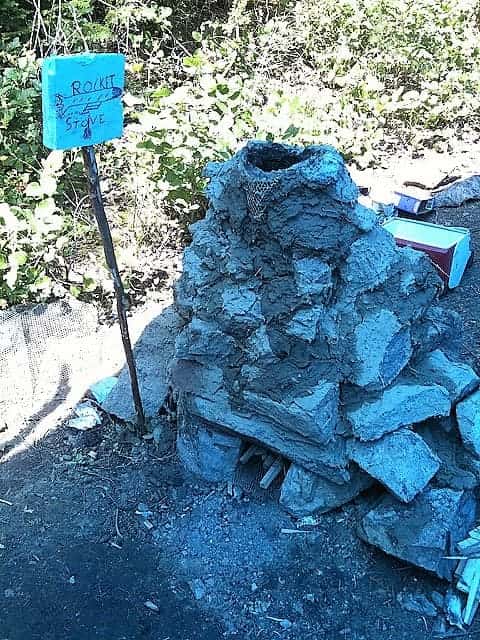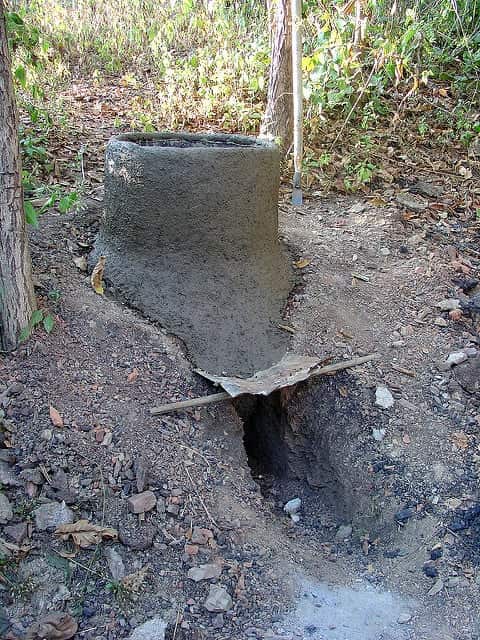In my opinion, everyone should know how to make a rocket stove. They are incredibly easy to DIY, can be made of various found materials, and a rocket stove could save your life in a survival situation!
Compared to other off-grid stoves, a rocket stove is incredibly efficient. The efficiency has to do with the J-shaped rocket stove design:
Fuel is burned in a chamber that has an insulated, internal vertical chimney.
The internal chimney means a strong draft is made, so the fuel is vigorously combusted. The J-shaped design of a rocket stove ensures that the fuel is almost completely combusted before the flame reaches your cooking pots or pans.
You get to burn a small amount of fuel and extract the most possible heat from it and the exhaust gases.
There are many ways to make rocket stoves and many material options. I’m going to share some rocket stove designs below.
Here are some design factors that you should keep in mind:
- Insulate everywhere around the fire except the place where the fire/heat reaches the cooking surface
- You need good airflow to the firebox; adding an extra hole will significantly improve airflow and combustion!
- Force heat up around narrow passages around the cooking surface
- Use small pieces of wood/fuel so they will completely combust
1. Really Basic Tin Can Rocket Stove
This rocket stove design is incredibly basic and could be used in a power outage. However, I would NOT recommend this rocket stove for long-term use. As you can see, the tin can isn’t insulated in any way, so you will lose a lot of heat.


2. Coffee Can Rocket Stove
This rocket stove design is a significant improvement over the previous one. The design means that the rocket stove can be insulated for better efficiency.
To make the rocket stove, you need a large coffee can, a J-shaped pipe, or two soup cans cut and placed together to create a J-shape. Cut the coffee can so you can fit the pipe inside it. Fill the space with vermiculite, rockets, etc.
You are ready to go!

3. Barrel Rocket Stove Design
Why is this rocket stove design so great? Note the small holes around the base of the barrel (burn tube). This improves airflow and increases combustion, making the rocket stove burn more efficiently.

4. Brick Rocket Stove
This design shows how easy it is to make a rocket stove out of found materials. Just stick a pipe in the bottom of the brick construction to serve as your “fuel tube.” You’ll lose some heat through the gaps in the bricks, but they will also help with the airflow.
Read how to make a brick rocket stove.

5. Clay Rocket Stove
You can easily construct a clay rocket stove of any size. The clay is a natural insulator, so the rocket stove design is very efficient.
Just be warned that you’ve got to build the rocket stove in layers so it won’t collapse or use some wires to make a frame for it.
You’ll also want it to be dry before using it.

6. Mud and Rocks Rocket Stove
Don’t have any clay? Just use mud and rocks to build up your rocket stove. It looks primitive, but it works very well.
Note the extra hole at the bottom right of the rocket stove. This design element helps improve airflow and combustion. When making a rocket stove this big, you’ll want to add that extra hole!

7. Dugout Rocket Stove
This rocket stove design is based on the Dakota Fire Hole. I love how they used a combination of mud and dry grass to build up the stove. This is actually how bricks used to be made and is very strong!
Note that the fuel hole is very tall here. As mentioned above, airflow can be a problem with large rocket stoves. You’ll either need to add a side hole or make the fuel hole larger.

8. Rocket Oven Design
Want to bake survival bread, pizza, or other things? Here is a great rocket oven design precisely for that purpose.
The rocket oven is made from various found objects, including bricks, clay, and a barrel.
Note that you MUST HAVE A CHIMNEY. Hopefully, this is obvious, but I’m mentioning it just in case 😉


9. Indoor Rocket Stove Design (“Good Stove”)
Rocket stoves burn fuel very efficiently, so there is little smoke and risk of carbon monoxide poisoning. However, you still need to be VERY careful when using a rocket stove indoors.
See here if you want to read about safe indoor stoves.
According to WHO, more than 4 million people die yearly from indoor smoke inhalation.
A geo-ecologist named Dr. N. Sai Bhaskar Reddy has made it his mission to improve stove designs and prevent poisoning. This rocket stove is based on one of his plans.
You can’t see it very well in the picture, but the rocket stove has an additional hole to the right. This extra air chamber improves combustion and decreases the number of gases produced.
You can see diagrams of the rocket stove design here.

Have you ever tried making a rocket stove? How long did it take you to boil water with it?
“Rocket Stove (6)” (CC BY-NC 2.0) by Backdoor Survival
“rocket stove” (CC BY-NC-ND 2.0) by campwaubanong“Making tea on a rocket stove” (CC BY 2.0) by dam
“rocket stove” (CC BY-NC 2.0) by Dane Larsen
“stovetec rocket stove 01” (CC BY-NC 2.0) by The Year of Mud
“Rocket Stove” (CC BY-NC 2.0) by jamesmnz
“08.06.2015 Jugando con fuego. Taller de” (CC BY-SA 2.0) by Medialab Prado
“08.06.2015 Jugando con fuego. Taller de” (CC BY-SA 2.0) by Medialab Prado
“Improvised dry stacked brick rocket stov” (CC BY 2.0) by wsssst
“rocket stove” (CC BY 2.0) by Yuichiro Haga
“rocket stove” (CC BY-NC-ND 2.0) by nicknormal


